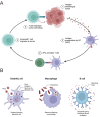The complex role of immune cells in antigen presentation and regulation of T-cell responses in hepatocellular carcinoma: progress, challenges, and future directions
- PMID: 39502703
- PMCID: PMC11534672
- DOI: 10.3389/fimmu.2024.1483834
The complex role of immune cells in antigen presentation and regulation of T-cell responses in hepatocellular carcinoma: progress, challenges, and future directions
Abstract
Hepatocellular carcinoma (HCC) is a prevalent form of liver cancer that poses significant challenges regarding morbidity and mortality rates. In the context of HCC, immune cells play a vital role, especially concerning the presentation of antigens. This review explores the intricate interactions among immune cells within HCC, focusing on their functions in antigen presentation and the modulation of T-cell responses. We begin by summarizing the strategies that HCC uses to escape immune recognition, emphasizing the delicate equilibrium between immune surveillance and evasion. Next, we investigate the specific functions of various types of immune cells, including dendritic cells, natural killer (NK) cells, and CD8+ T cells, in the process of antigen presentation. We also examine the impact of immune checkpoints, such as cytotoxic T-lymphocyte-associated protein 4 (CTLA-4) and the pathways involving programmed cell death protein 1 (PD-1) and programmed death ligand 1 (PD-L1), on antigen presentation, while taking into account the clinical significance of checkpoint inhibitors. The review further emphasizes the importance of immune-based therapies, including cancer vaccines and CAR-T cell therapy, in improving antigen presentation. In conclusion, we encapsulate the latest advancements in research, propose future avenues for exploration, and stress the importance of innovative technologies and customized treatment strategies. By thoroughly analyzing the interactions of immune cells throughout the antigen presentation process in HCC, this review provides an up-to-date perspective on the field, setting the stage for new therapeutic approaches.
Keywords: CTLA-4; PD-1/PD-L1; dendritic cells; hepatocellular carcinoma; natural killer cells.
Copyright © 2024 Ning, Wang and Tao.
Conflict of interest statement
The authors declare that the research was conducted in the absence of any commercial or financial relationships that could be construed as a potential conflict of interest.
Figures



Similar articles
-
Strategies to Improve the Antitumor Effect of Immunotherapy for Hepatocellular Carcinoma.Front Immunol. 2021 Nov 26;12:783236. doi: 10.3389/fimmu.2021.783236. eCollection 2021. Front Immunol. 2021. PMID: 34899747 Free PMC article. Review.
-
Antibodies Against Immune Checkpoint Molecules Restore Functions of Tumor-Infiltrating T Cells in Hepatocellular Carcinomas.Gastroenterology. 2017 Oct;153(4):1107-1119.e10. doi: 10.1053/j.gastro.2017.06.017. Epub 2017 Jun 23. Gastroenterology. 2017. PMID: 28648905
-
The interactions between major immune effector cells and Hepatocellular Carcinoma: A systematic review.Int Immunopharmacol. 2021 Dec;101(Pt A):108220. doi: 10.1016/j.intimp.2021.108220. Epub 2021 Oct 18. Int Immunopharmacol. 2021. PMID: 34673334
-
Anti-PD-1/PD-L1 Blockade Immunotherapy Employed in Treating Hepatitis B Virus Infection-Related Advanced Hepatocellular Carcinoma: A Literature Review.Front Immunol. 2020 May 28;11:1037. doi: 10.3389/fimmu.2020.01037. eCollection 2020. Front Immunol. 2020. PMID: 32547550 Free PMC article. Review.
-
Natural Killer Cells and T Cells in Hepatocellular Carcinoma and Viral Hepatitis: Current Status and Perspectives for Future Immunotherapeutic Approaches.Cells. 2021 May 28;10(6):1332. doi: 10.3390/cells10061332. Cells. 2021. PMID: 34071188 Free PMC article. Review.
Cited by
-
Structural and temporal dynamics analysis of PD-1/PD-L1 immunotherapy in hepatocellular carcinoma: History, research hotspots, and emerging trends.Hum Vaccin Immunother. 2025 Dec;21(1):2540143. doi: 10.1080/21645515.2025.2540143. Epub 2025 Aug 17. Hum Vaccin Immunother. 2025. PMID: 40820303 Free PMC article.
-
Overcoming barriers in glioblastoma: The potential of CAR T cell immunotherapy.Theranostics. 2025 Jun 12;15(14):7090-7126. doi: 10.7150/thno.114257. eCollection 2025. Theranostics. 2025. PMID: 40585996 Free PMC article. Review.
-
Changing landscape of advanced esophageal squamous cell carcinoma: Breakthroughs in systemic therapies (Review).Oncol Rep. 2025 Oct;54(4):120. doi: 10.3892/or.2025.8953. Epub 2025 Jul 19. Oncol Rep. 2025. PMID: 40682837 Free PMC article. Review.
-
Integrating inflammation, nutrition, and immunity: the CALLY index as a prognostic tool in digestive system cancers - a systematic review and meta-analysis.BMC Cancer. 2025 Apr 11;25(1):672. doi: 10.1186/s12885-025-14074-3. BMC Cancer. 2025. PMID: 40217204 Free PMC article.
-
Construction and evaluation of a prognostic model of autophagy-related genes in hepatocellular carcinoma.Biochem Biophys Rep. 2024 Dec 12;41:101893. doi: 10.1016/j.bbrep.2024.101893. eCollection 2025 Mar. Biochem Biophys Rep. 2024. PMID: 39760097 Free PMC article.
References
Publication types
MeSH terms
Substances
LinkOut - more resources
Full Text Sources
Medical
Research Materials

